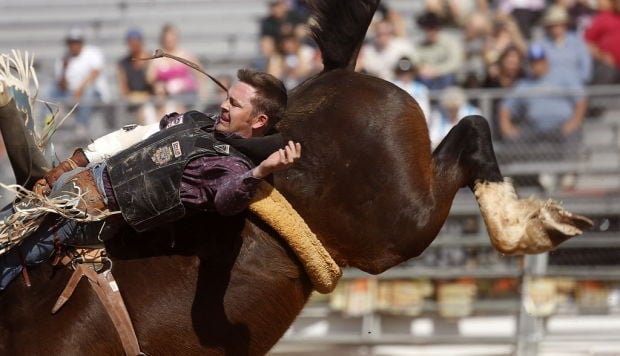If she leaned any farther over the railing, my mother would’ve fallen over it.
You don’t want to know what she would’ve fallen into.
This isn’t Judy Gold’s first rodeo, but it’s been a while. More than 60 years, actually.
She’s leaning so close she can feel the bulls snort as they get into their chutes, and she’s loving every minute of it, except the dust. Too much dust.
The last time she was at a rodeo was in 1954, back in New Jersey, where a little Jewish girl from Hillside gazed starry-eyed at Roy Rogers. She met Dale Evans. She got to pet Trigger.
When I told her I was covering La Fiesta de los Vaqueros — the Tucson Rodeo — she beamed like the sun over the city, her new home. She had to go see the horses. A new Trigger.
It’s more than the horses, though. It’s the pageantry and the showmanship and the total buy-in from the crowd. It’s the smells and the tastes — sweet potato chips, not bad — and Justin Rumford, the goofiest, roundest barrel man in the business, goading a girl from the audience to practice his cheerleader routine. My mom laughs. It’s nice to see.
Behind her, a young girl sat with her mother and grandmother, three generations at the rodeo.
“My mom is 90, and she comes to the rodeo every year, too,” Tucson Rodeo general manager Gary Williams said.
Williams grew up with this stuff, has been involved as long as he can remember. He’s 66 now, the head man in charge of one of the biggest rodeos in the Southwest, and he’s seen everything.
Not much tickles him like seeing newcomers at the rodeo — young and old.
There’s something in the cowboy, he believes, that beckons folks with stars in their eyes and dirt on their jeans.
“I’ve always maintained that everyone who grew up in the United States at sometime wanted to be a cowboy,” Williams said. “I don’t think you can say that about anything else. The reason for it is the image — doing the right thing, telling the truth, standing up for rights, not backing down — it’s all those things.”
My mom remembers that rodeo, long ago, when she had her pigtails and her plaid shirt and her belt buckle and toy gun. She was a tomboy, she says, and six decades later, she’s not much taller now than she was then.
Watching the barrel racing competition, she claps. She leans forward to get a closer look at the horses, but if the timing were right, and she had the right boost, “I was ready to jump onto one of the horses!”
She’ll wave as the banner horses sprint by, a rider atop each, the biggest cheer, the only cheer, going to Whataburger. Fitting, as they’ve just completed the steer wrestling part of the competition.
“We’ve done demographic surveys with people: When you go to a rodeo, what do you perceive it as, a professional sporting event, a show?” Williams said. “They perceive it as a rodeo. It’s a lifestyle. This is not just a sport — these guys live it, eat it, breathe it.”
The fans, too, young and old, and particularly the young, Williams hopes.
“It’s extremely important to pass this down to the generations, not only because we’re creating future rodeo fans, but, we hope, future generations of people who have the same moral values, the same ethics,” he said.
He was once the young child hoping to see the 80-point ride, the quick takedown of a nasty steer. My mom hasn’t been to a rodeo in 60 years; Williams hasn’t gone a year without being at one over the last six decades. He says he was “back here behind the chutes when I was a little kid. I was enthralled. I didn’t want to give it up.”
“My parents brought me to my first rodeo when I was less than a month old,” Williams said. “And I can’t say I’ve been to every one since … but it’s a lot.”
Lucky him, my mom says.






